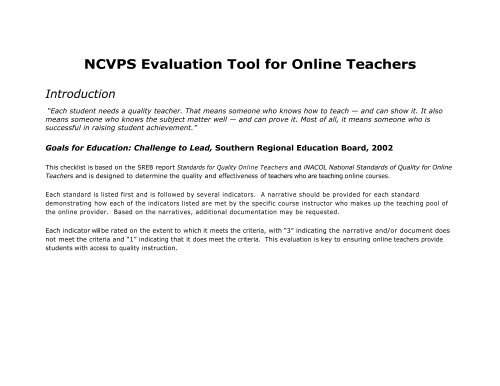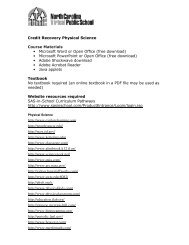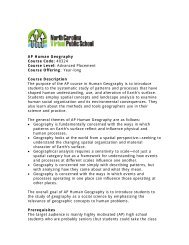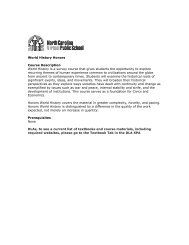NCVPS Evaluation Tool for Online Teachers - North Carolina Virtual ...
NCVPS Evaluation Tool for Online Teachers - North Carolina Virtual ...
NCVPS Evaluation Tool for Online Teachers - North Carolina Virtual ...
Create successful ePaper yourself
Turn your PDF publications into a flip-book with our unique Google optimized e-Paper software.
Introduction<br />
<strong>NCVPS</strong> <strong>Evaluation</strong> <strong>Tool</strong> <strong>for</strong> <strong>Online</strong> <strong>Teachers</strong><br />
“Each student needs a quality teacher. That means someone who knows how to teach — and can show it. It also<br />
means someone who knows the subject matter well — and can prove it. Most of all, it means someone who is<br />
successful in raising student achievement.”<br />
Goals <strong>for</strong> Education: Challenge to Lead, Southern Regional Education Board, 2002<br />
This checklist is based on the SREB report Standards <strong>for</strong> Quality <strong>Online</strong> <strong>Teachers</strong> and iNACOL National Standards of Quality <strong>for</strong> <strong>Online</strong><br />
<strong>Teachers</strong> and is designed to determine the quality and effectiveness of teachers who are teaching online courses.<br />
Each standard is listed first and is followed by several indicators. A narrative should be provided <strong>for</strong> each standard<br />
demonstrating how each of the indicators listed are met by the specific course instructor who makes up the teaching pool of<br />
the online provider. Based on the narratives, additional documentation may be requested.<br />
Each indicator will be rated on the extent to which it meets the criteria, with “3” indicating the narrative and/or document does<br />
not meet the criteria and “1” indicating that it does meet the criteria. This evaluation is key to ensuring online teachers provide<br />
students with access to quality instruction.
A<br />
ü�<br />
The teacher meets the professional teaching standards established by <strong>North</strong><br />
<strong>Carolina</strong> and the teacher has academic credentials in the field in which he or<br />
she is teaching.<br />
1.Meets the state’s professional teaching standards or has academic credentials in the field in which he or she is<br />
teaching.<br />
ü� 2. Provides evidence that he or she has credentials in the field of study to be taught.<br />
ü� 3. Knows the content of the subject to be taught and understands how to teach the content to students.<br />
ü� 4. Facilitates the construction of knowledge through an understanding of how students learn in specific subject areas.<br />
ü� 5. Continues to update academic knowledge and skills.<br />
B The teacher has the prerequisite technology skills to teach online.<br />
ü�<br />
1. Demonstrates the ability to effectively use word-processing, spreadsheet and presentation software.<br />
Evidence Provided<br />
Through<br />
Narrative<br />
Evidence Provided<br />
Through Narrative
ü� 2. Demonstrates effective use of Internet browsers, e-mail applications and appropriate online etiquette.<br />
ü�<br />
3. Utilizes synchronous and asynchronous tools (e.g., discussion boards, chat tools, electronic whiteboards)<br />
effectively<br />
ü� 4. Troubleshoots typical software and hardware problems (i.e. change passwords, download plug-ins, etc).<br />
ü�<br />
C<br />
ü�<br />
5. Demonstrates growth in technology knowledge and skills in order to stay current with emerging technologies and<br />
trends.<br />
The teacher plans, designs and incorporates strategies to encourage active<br />
learning, interaction, participation and collaboration in the online<br />
environment.<br />
1. Demonstrates effective strategies and techniques that actively engage students in the learning process (e.g., team<br />
problem-solving, in-class writing, analysis, synthesis and evaluation instead of passive lectures).<br />
ü� 2. Facilitates and monitors appropriate interaction among students.<br />
ü�<br />
3. Builds and maintains a community of learners by creating a relationship of trust, demonstrating effective<br />
facilitation skills, establishing consistent and reliable expectations, and supporting and encouraging independence<br />
and creativity.<br />
ü� 4. Promotes learning through group interaction.<br />
Evidence Provided<br />
Through<br />
Narrative
ü�<br />
ü�<br />
ü�<br />
5. Leads online instruction groups that are goal-oriented, focused, project-based and inquiry-oriented.<br />
6. Demonstrates knowledge and responds appropriately to the cultural background and learning needs of non-native<br />
English speakers.<br />
7. Differentiates instruction based on students’ learning styles and needs and assists students in assimilating<br />
in<strong>for</strong>mation to gain understanding and knowledge.<br />
ü� 8. Demonstrates growth in teaching strategies in order to benefit from current research and practice.<br />
ü�<br />
9. Creates a warm and inviting atmosphere that promotes the development of a sense of community among<br />
participants.<br />
ü� 10. Encourages students to bring real-life examples into the online classroom.<br />
ü� 11. Mandates participation by setting limits if participation wanes or if the conversation is headed in the wrong direction.<br />
ü� 12. Provides structure <strong>for</strong> students but allows <strong>for</strong> flexibility and negotiation.<br />
ü� 13. Uses best practices to promote participation.<br />
ü�<br />
14. Begins each lesson with a short, student-friendly, summary statement indicating the goal of the lesson and the<br />
primary benchmarks that will be covered.
ü� 15. Provides extended resources and activities to increase achievement levels.<br />
D<br />
The teacher provides online leadership in a manner that promotes student<br />
success through regular feedback, prompt response and clear expectations.<br />
ü� 1. Models effective communication skills and maintains records of applicable communications with students.<br />
ü�<br />
2. Encourages interaction and cooperation among students, encourages active learning, provides prompt feedback,<br />
communicates high expectations, and respects diverse talents and learning styles.<br />
ü� 3. Persists, in a consistent and reasonable manner, until students are successful.<br />
ü�<br />
ü�<br />
ü�<br />
4. Establishes and maintains ongoing and frequent teacher-student interaction, student- student interaction and<br />
teacher-parent interaction.<br />
5. Provides an online syllabus that defines objectives, concepts and learning outcomes in a clearly written, concise<br />
<strong>for</strong>mat.<br />
6. Provides an online syllabus that defines the terms of class interaction <strong>for</strong> both teacher and students, defines clear<br />
expectations <strong>for</strong> both teacher and students, defines the grading criteria, establishes inappropriate behavior criteria <strong>for</strong><br />
both teacher and students, and explains the course organization to students.<br />
Evidence Provided<br />
Through<br />
Narrative
ü�<br />
7. Uses student data to in<strong>for</strong>m instruction, guides and monitors students’ management of their time, monitors learner<br />
progress with available tools and develops an intervention plan <strong>for</strong> unsuccessful learners.<br />
ü� 8. Provides timely, constructive feedback to students about assignments and questions.<br />
ü� 9. Gives students clear expectations about teacher response time.<br />
ü� 10. Contacts students who are not participating.<br />
ü�<br />
11. Recognizes that student interaction with the lesson has instructional value and there<strong>for</strong>e encourages students<br />
to participate in leading the instruction and /or demonstrating mastery of the content in other appropriate ways.<br />
ü� 12. Personalizes feedback (support, growth and encouragement).*<br />
ü� 13. Communicates high expectations.*<br />
E<br />
ü�<br />
The teacher models, guides and encourages legal, ethical, safe, and healthy<br />
behavior related to technology use.<br />
1. Facilitates student investigations of the legal and ethical issues related to technology and society; teaches students that copyright laws are<br />
created <strong>for</strong> a reason.<br />
Evidence Provided<br />
Through<br />
Narrative
ü�<br />
2. Facilitates student investigations of the legal and ethical issues related to technology and society; teaches students that<br />
copyright laws are created <strong>for</strong> a reason.<br />
ü� 3. Identifies the risks of academic dishonesty <strong>for</strong> students.<br />
ü� 4. Uses course content that complies with intellectual property rights policies and fair use standards.<br />
ü� 5. Provides students with an understanding of the importance of Acceptable Use Policies (AUP).<br />
F<br />
ü�<br />
The teacher has experienced online learning from the perspective of a<br />
student.<br />
1. Has taken an online course and applies experiences as an online student to develop and implement<br />
successful strategies <strong>for</strong> online teaching.<br />
ü� 2. Demonstrates the ability to anticipate challenges and problems in the online classroom.<br />
Evidence Provided<br />
Through<br />
Narrative
ü�<br />
G<br />
ü�<br />
3. Demonstrates an understanding of the perspective of the online student through appropriate<br />
responsiveness and a supportive attitude toward students.<br />
The teacher understands and is responsive to students with special needs in the<br />
online classroom.<br />
1. Understands that students have varied talents and skills and uses appropriate strategies designed to include<br />
all students.<br />
ü� 2. Provides activities, modified as necessary, that are relevant to the needs of all students.<br />
ü� 3. Adapts and adjusts instruction to create multiple paths to learning objectives.<br />
ü� 4. Encourages collaboration and interaction among all students.<br />
ü� 5. Exhibits the ability to assess student knowledge and instruction in a variety of ways.<br />
ü�<br />
6. Provides student-centered lessons and activities that are based on concepts of active learning and that are connected<br />
to real-world applications.<br />
ü� 7. Demonstrates ability to identify students struggling with ELL or literacy issues and delivers specific strategies.<br />
Evidence Provided<br />
Through<br />
Narrative
ü� 8. Identifies options to expand student thinking, address styles of learning and avenues <strong>for</strong> enrichment or intervention.<br />
ü� 9. Knows how to implement a team teaching concept.<br />
H<br />
ü�<br />
The teacher demonstrates competencies in creating and implementing<br />
assessments in online learning environments in ways that assure validity and<br />
reliability of instruments and procedures.<br />
1. Creates or selects fair, adequate and appropriate assessment instruments to measure online learning that reflect<br />
sufficient content validity (i.e., that adequately cover the content they are designed to measure), reliability and<br />
consistency over time.<br />
ü� 2. Implements online assessment measures and materials in ways that ensure instrument validity and reliability.<br />
I<br />
ü�<br />
The teacher develops and delivers assessments, projects, and assignments that<br />
meet standards-based learning goals and assesses learning progress by<br />
measuring student achievement of learning goals.<br />
1. Includes authentic assessment (i.e., the opportunity to demonstrate understanding of acquired knowledge and skills<br />
as opposed to testing isolated skills or retained facts)<br />
as part of the evaluation process; assesses student knowledge in a <strong>for</strong>um beyond multiple guess.<br />
Evidence Provided<br />
Through<br />
Narrative<br />
Evidence Provided<br />
Through<br />
Narrative
ü�<br />
ü�<br />
J<br />
2. Provides continuous evaluation of students to include pre- and post-testing and student input throughout the<br />
course.<br />
3. Demonstrates an understanding of the relationships between and among the assignments, assessments and<br />
standards-based learning goals.<br />
The teacher demonstrates competencies in using data and findings from<br />
assessments and other data sources to modify instructional methods and<br />
content and to guide student learning.<br />
ü� 1. Assesses each student’s background and content knowledge and uses these data to plan instruction.<br />
ü� 2. Reviews student responses to test items to identify issues related to test validity or instructional effectiveness.<br />
ü�<br />
ü�<br />
ü�<br />
ü�<br />
3. Uses observational data (e.g., tracking data in electronic courses, Web logs, e-mail) to monitor course progress and<br />
effectiveness.<br />
4. Creates opportunities <strong>for</strong> self-reflection or assessment of teaching effectiveness within the online environment (e.g., classroom<br />
assessment techniques, teacher evaluations, teacher peer reviews).<br />
5. Addresses multiple intelligences and levels of ability through a variety of alternative interventions such as adjusting<br />
lessons based upon re-teaching and using varied assessment strategies.<br />
6. Provides evidence of effective learning strategies that worked <strong>for</strong> the individual student and details specific changes in<br />
future instruction based upon assessment results and research study (data-driven and research- based).<br />
Evidence Provided<br />
Through<br />
Narrative
ü�<br />
K<br />
7. Evaluates instructional strategies to determine their accuracy and usefulness <strong>for</strong> presenting specific ideas and<br />
concepts.<br />
The teacher demonstrates frequent and effective strategies that enable both<br />
teacher and students to complete self- and pre-assessments.<br />
ü� 1. Employs ways to assess student readiness <strong>for</strong> course content and method of delivery.<br />
ü�<br />
ü�<br />
2. Employs ways <strong>for</strong> students to effectively evaluate and assess their own readiness <strong>for</strong> course content and method of<br />
delivery.<br />
3. Understands that student success (e.g., grade, level of participation, mastery of content, completion percentage)<br />
is an important measure of teaching and course success.<br />
ü� 4. Provides opportunities <strong>for</strong> student self-assessment within courses.<br />
ü�<br />
L<br />
5. Empowers students to independently define short- and long-term learning goals and monitors their personal<br />
progress.<br />
The teacher collaborates with colleagues.<br />
ü� 1. Networks with others involved in online education.<br />
Evidence Provided<br />
Through<br />
Narrative<br />
Evidence Provided<br />
Through<br />
Narrative
ü�<br />
2. Leads collaborative ef<strong>for</strong>ts to create common assessments among grade-level and /or content-area teachers and share<br />
assessment results with colleagues to collaboratively plan instruction that will best meet individual student needs.<br />
Instructional Design<br />
The following section outlines standards <strong>for</strong> instructional design skills <strong>for</strong> the online teacher of record, where applicable.<br />
These standards are considered optional, as instructional design does not always fall under online teaching<br />
responsibilities.<br />
M<br />
ü�<br />
The teacher arranges media and content to help students and teachers transfer<br />
knowledge most effectively in the online environment.<br />
1. Demonstrates the ability to modify and add content and assessment, using an<br />
online Learning Management System (LMS).<br />
ü� 2. Incorporates multimedia and visual resources into an online module.<br />
ü�<br />
ü�<br />
3. Demonstrates the ability to effectively use and incorporate subject-specific<br />
and developmentally appropriate software in an online learning module.<br />
4. Reviews all materials and Web resources <strong>for</strong> their alignment with course<br />
objectives and state and local standards and <strong>for</strong> their appropriateness on a<br />
continuing basis.<br />
Evidence Provided<br />
Through<br />
Narrative
ü�<br />
ü�<br />
5. Creates assignments, projects and assessments that are aligned with students’<br />
different visual, auditory and hands-on ways of learning.<br />
6. Arranges media and content to help transfer knowledge most effectively in the<br />
online environment.<br />
SREB Educational Technology Cooperative, . "SREB Standards <strong>for</strong> Quality <strong>Online</strong> Teaching." SREB SREB Educational Technology<br />
Cooperative. SREB, August 2006. Web. 12 Sep 2011.<br />
.<br />
iNACOL International Association <strong>for</strong> K-12 <strong>Online</strong> Learning, . "National Standards <strong>for</strong> Quality <strong>Online</strong> Teaching." iNACOL<br />
International Association <strong>for</strong> K-12 <strong>Online</strong> Learning. iNACOL International Association <strong>for</strong> K-12 <strong>Online</strong> Learning, August 2010.<br />
Web. 12 Sep 2011.<br />
.





